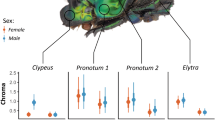Abstract
Charles Darwin proposed a separate theory of sexual selection, as distinct from his theory of natural selection, to account for adaptations that confer success in finding a mate, which may sometimes be quite the opposite of what is best for survival. Darwin’s proposal that females have a sense of beauty and choose mating partners that appear beautiful to them was met with much scepticism. But today we have a rather detailed understanding of what animals find beautiful and why. In this article, I will describe a few very simple experiments performed by Michael J. Ryan, in collaboration with A. Stanley Rand, herpetologist extraordinaire and Merlin D Tuttle of the Bat Conservation International fame, that laid the foundation for our current understanding of the meaning and evolution of beauty. Studying the túngara frog on Barro Colorado Island, a research station of the Smithsonian Tropical Research Institute in Panama, they showed that (1) male túngara frogs can produce both simple calls, consisting of just a whine, or complex calls in which one or more chucks are added to the whine, (2) female túngara frogs have a decided preference to mate with males giving complex calls, (3) males are nevertheless reluctant to add chucks to their calls and generally do so only when they hear other males calling, and (4) the local predatory fringe-lipped bat also has a decided preference to eat males giving complex calls. Male tungara frogs thus face a trade-off between sex and survival. These experiments not only answered the question of why males don’t do their best when it comes to singing, but they also set the stage for many more sophisticated investigations that have led to an understanding of how and why natural selection has favoured this particular sexual aesthetic in the frogs and this particular culinary aesthetic in the bats.
Similar content being viewed by others
Suggested Reading
K D Wells, The Ecology & Behaviour of Amphibians, The University of Chicago Press, Chicago and London, 2007.
M J Ryan, An improbable path. In Drickamer, L., and Dewsbury, D., eds., Leaders in Animal Behavior: The Second Generation, pp.465–96, Cambridge: Cambridge University Press, 2010.
M J Ryan, A Taste for the Beautiful: The Evolution of Attraction, Princeton University Press, Princeton and Oxford, 2018.
M J Ryan, The Túngara Frog — A Study in Sexual Selection and Communication, University of Chicago Press, Chicago and London, 1985.
M J Ryan, Profile: A Stanley Rand, (1932–2005), Iguana 13: pp.43–46, 2006.
A S Rand and M J Ryan The Adaptive Significance of a Complex Vocal Repertoire in a Neotropical Frog, Z. Tierpsychol, Vol.57, pp.209–14, 1981.
M J Ryan M D Tittle and A S Rand, Bat Predation and Sexual Advertisement in a Neotropical Frog, Amer. Natur., Vol.119, pp.136–39, 1982.
R Gadagkar, In Love with Ropalidia marginata: 34 years, and Still Going Strong, In: Social Behaviour: Genes, Ecology and Evolution, (Eds.) T Szekely, A J Moore and J Komdeur, Cambridge University Press, Cambridge, pp.85–87, 2010.
Acknowledgements
I thank Michael Ryan, Sujata Deshpande, Maria Modanu and TNC Vidya for many helpful comments on this article.
Author information
Authors and Affiliations
Corresponding author
Additional information
Raghavendra Gadagkar is DST Year of Science Chair Professor at the Centre for Ecological Sciences, Indian Institute of Science, Bangalore, Honorary Professor at JNCASR, and Non-Resident Permanent Fellow of the Wissenschaftskolleg (Institute for Advanced Study), Berlin. During the past 40 years he has established an active school of research in the area of animal behaviour, ecology and evolution. The origin and evolution of cooperation in animals, especially in social insects, such as ants, bees and wasps, is a major goal of his research. http://ces.iisc.ac.in/hpg/ragh. https://www.researchgate.net/profile/Raghavendra_Gadagkar
Rights and permissions
About this article
Cite this article
Gadagkar, R. How to Design Experiments in Animal Behaviour. Reson 25, 817–838 (2020). https://doi.org/10.1007/s12045-020-0998-7
Published:
Issue Date:
DOI: https://doi.org/10.1007/s12045-020-0998-7




